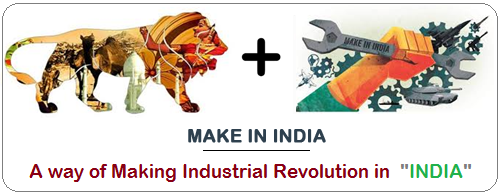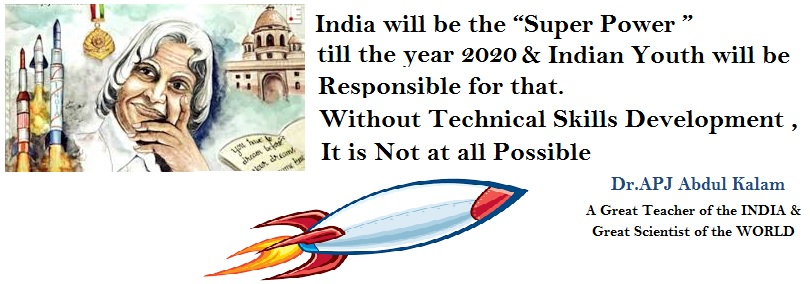- How will India become the hub of Technological Industries?
- What are the steps Indian Government taking to promote the Technological manufacturing & R&D Sector in India?
- How huge Employment Generation will happen in India ?
& So on , Many questions. Answers of all your questions will get in this article.
” To Happen Technological Revolution in India, We Need Huge Technically Skillful Human Resources – Mr.Narendra Modi, Priminister, India “
Introduction
Manufacturing has emerged as one of the high growth sectors in India. Prime Minister of India, Mr Narendra Modi, had launched the ‘Make in India’ program to place India on the world map as a manufacturing hub and give global recognition to the Indian economy. India is expected to become the fifth largest manufacturing country in the world by the end of the year 2020.
Market Size
The Gross Value Added (GVA) at basic current prices from the manufacturing sector in India grew at a CAGR of 4.34 per cent during FY12 and FY18 as per the second advance estimates of annual national income published by the Government of India. Quarterly GVA at basic prices from manufacturing sector grew by 10.92 per cent in the third quarter of FY18. Under the Make in India initiative, the Government of India aims to increase the share of the manufacturing sector to the gross domestic product (GDP) to 25 per cent by 2022, from 16 per cent, and to create 100 million new jobs by 2022. Business conditions in the Indian manufacturing sector continue to remain positive.
Investments
With the help of Make in India drive, India is on the path of becoming the hub for hi-tech manufacturing as global giants such as GE, Siemens, HTC, Toshiba, and Boeing have either set up or are in process of setting up manufacturing plants in India, attracted by India’s market of more than a billion consumers and increasing purchasing power.
Cumulative Foreign Direct Investment (FDI) in India’s manufacturing sector reached US$ 73.70 billion during April 2000-December 2017.
India has become one of the most attractive destinations for investments in the manufacturing sector. Some of the major investments and developments in this sector in the recent past are:
- Mahindra and Mahindra is planning to start operating a fleet of electric cabs and supplying parts to Electric Vehicle (EV) manufacturers.
- Grasim Industries has received clearance for expansion of its plant at Vilayat. The expansion will entail an investment of Rs 2,560 crore (US$ 396.8 million)
- Over 350 mobile charger factories are expected to be set up in India by 2025, on the back of the government’s push to encourage production of battery chargers. Setting up of these factories is expected to lead to production of 1.46 billion chargers and generation of 0.8 million jobs.
- Government of India is planning to invite bids for setting up of 20 Gigawatts (GW) of solar power capacity with the objective of boosting domestic manufacturing of solar power equipment.
- JSW Energy has signed a memorandum of understanding (MoU) with the Government of Gujarat, for setting up an electric vehicle (EV) manufacturing unit in Gujarat at an estimated cost of Rs 4,000 crore (US$ 608.88 million).
- With an aim to increase its presence in India, Denmark-based heating ventilation and air-conditioning (HVAC) giant, Danfoss, is planning to take its manufacturing localisation to 50 per cent as well as double its supplier base in India by 2020.
Government Initiatives
The Government of India has taken several initiatives to promote a healthy environment for the growth of manufacturing sector in the country. Some of the notable initiatives and developments are:
- As of March 2018, Government of India is in the process of coming up with a new industrial policy which envisions development of a globally competitive Indian industry.
- The government has introduced two new World Bank assisted projects viz. SANKALP scheme and STRIVE scheme for skill development in the country.
- In Union Budget 2018-19, the Government of India reduced the income tax rate to 25 per cent for all companies having a turnover of up to Rs 250 crore (US$ 38.75 million).
- Under the Mid-Term Review of Foreign Trade Policy (2015-20), the Government of India increased export incentives available to labour intensive MSME sectors by 2 per cent.
- The Ministry of Electronics and Information Technology is in the process of formulation of a new electronics manufacturing policy. The aim of the new policy will be to create an ecosystem of manufacturing in the country, enable India to become a significant global player in some of these categories.
- Ministry of Home Affairs liberalised Arms Rules to boost ‘Make in India’ manufacturing policy of the government. The liberalisation of the policy is expected to encourage investment in the manufacturing of arms and ammunition and weapon systems and promote employment generation.There so many such initiative taken by Indian government.
Road Ahead
India is an attractive hub for foreign investments in the manufacturing sector. Several mobile phone, luxury and automobile brands, among others, have set up or are looking to establish their manufacturing bases in the country.
The manufacturing sector of India has the potential to reach US$ 1 trillion by 2025 and India is expected to rank amongst the top three growth economies and manufacturing destination of the world by the year 2020. The implementation of the Goods and Services Tax (GST) will make India a common market with a GDP of US$ 2.5 trillion along with a population of 1.32 billion people, which will be a big draw for investors.
With impetus on developing industrial corridors and smart cities, the government aims to ensure holistic development of the nation. The corridors would further assist in integrating, monitoring and developing a conducive environment for the industrial development and will promote advance practices in manufacturing.
” Be Technically Skillful,
Take Right opportunity at Right Time
Be always one Step Ahead “
Thank You,
IIT Bombay Alumni’s
Embedded Technosolutions


